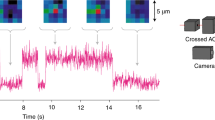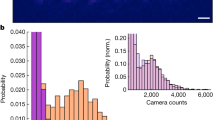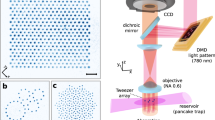Laser-trapped atoms in strings can be deftly rearranged and the spacing between them precisely adjusted.
Abstract
Laser cooling and trapping techniques allow us to control and manipulate neutral atoms1. Here we rearrange, with submicrometre precision, the positions and ordering of laser-trapped atoms within strings by manipulating individual atoms with optical tweezers2. Strings of equidistant atoms created in this way could serve as a scalable memory for quantum information3.
Similar content being viewed by others
Main
Atoms and molecules on surfaces have previously been rearranged at the nanometre-scale using scanning tunnelling microscopy4,5, and the first steps have been taken towards rearranging strings of trapped ions6. To realize a related technique in the context of cold-atom physics, we first trapped and cooled caesium atoms to sub-millikelvin temperatures inside a vacuum chamber using a magneto-optical trap1. These atoms were then transferred into a horizontal standing-wave optical dipole trap (HDT)1, formed by two counterpropagating laser beams.
The dipole-trap lasers are far detuned from all caesium transitions. They polarize the atoms and pull them into the intensity maxima, located at the antinodes and separated by about 0.5 µm. The trapped atoms (storage time of up to 1 min) are then randomly distributed over the antinodes, forming a string along the axis of the trap. We determined the position of each atom from a fluorescence image, recorded using an intensified charge-coupled device (ICCD) camera7,8.
By varying the relative phase of the trapping beams, the HDT can be moved along the x direction (Fig. 1a), shifting the string of atoms but leaving the interatomic separations unchanged8,9. To control these separations, we used a second, vertical standing-wave dipole trap (VDT) produced by retro-reflecting a focused laser beam (Fig. 1a).
a, Two crossed standing-wave dipole traps are used to rearrange strings of trapped neutral atoms. (For methods, see supplementary information.) b, Fluorescence image of an initial string of seven randomly separated atoms. c, The same atoms after rearranging six of them using the distance-control operation. Scale bar, 15 µm. d, Relation between the final and the initial distance between simultaneously trapped atoms recorded for about 190 atom pairs. For initial distances greater than 10µm, our distance-control operation successfully rearranges the atoms, resulting in a narrow distribution of final distances around the target distance dt=15 µm.
In both dipole traps, the confining forces along the trap axis are much larger than in the radial direction. Accordingly, an atom stored in the overlap region of both traps will always follow the axial motion of the traps. This allowed us selectively to extract an atom from the HDT: after transporting it along the x direction into the overlap region of both traps, the atom is shifted upwards by axially moving the standing-wave pattern of the VDT (step 1 in Fig. 1a). The string of atoms left in the HDT can be moved to any position along the HDT with respect to the VDT (step 2, Fig. 1a). By reinserting the extracted atom into the HDT, it can then be placed at any target distance dt from the remaining atoms (step 3, Fig. 1a).
Through sequential application of this distance-control operation (duration, 400 ms; success rate, 98(−5/+2)%; see below), atoms can be arranged in equidistant strings. A detailed sequence of ICCD images illustrates this procedure for three atoms (see supplementary information); Fig. 1b, c shows ICCD images of a string of seven atoms before and after rearrangement, respectively. The initially random separations have been equalized (dt=15 µm).
The results shown in Fig. 1d characterize the performance of the distance-control operation: for initial distances of more than 10 µm, we obtain a final distance of 15.27 µm, with a standard deviation of 0.78±0.05 µm. If the initial separation between atoms is less than 10 µm, extracting one of them leads to uncontrolled effects on the other atom (extraction, ejection and so on) owing to the 10-µm radius of the VDT.
Laser-trapped atoms are efficiently isolated from the environment and show little decoherence3,10. The equidistant strings of atoms produced by our method could therefore serve as a scalable, neutral-atom quantum register for storing and manipulating quantum information in the context of cavity quantum electrodynamics11 or controlled cold collisions12,13.
References
Metcalf, H. J. & van der Straten, P. Laser Cooling and Trapping (Springer, New York, 1999).
Grier, D. G. Nature 424, 810–816 (2003).
Schrader, D. et al. Phys. Rev. Lett. 93, 150–501 (2004).
Eigler, D. M. & Schweizer, E. K. Nature 344, 524–526 (1990).
Bartels, L., Meyer, G. & Rieder, K. -H. Phys. Rev. Lett. 79, 697–700 (1997).
Hensinger, W. K. et al. Appl. Phys. Lett. 88, 034–101 (2006)
Dotsenko, I. et al. Phys. Rev. Lett. 95, 033–002 (2005).
Miroshnychenko, Y. et al. Opt. Expr. 11, 3498–3502 (2003).
Kuhr, S. et al. Science 293, 278–280 (2001).
Kuhr, S. et al. Phys. Rev. Lett. 91, 213–002 (2003).
You, L., Yi, X. X. & Su, X. H. Phys. Rev. A 67, 032–308 (2003).
Jaksch, D., Briegel, H. -J., Cirac, J. I., Gardiner, C. W. & Zoller, P. Phys. Rev. Lett. 82, 1975–1978 (1999).
Mandel, O. et al. Nature 425, 937–940 (2003).
Author information
Authors and Affiliations
Corresponding author
Ethics declarations
Competing interests
The authors declare no competing financial interests.
Supplementary information
Supplementary Video 1
Sorting a string of three atoms. This animation shows ICCD images of the stepwise rearrangement of a string of three initially randomly separated atoms in the horizontal dipole trap into an equidistant string with 15 µm spacing. The lines on the first picture indicate the axes of the horizontal dipole trap (HDT) and the vertical dipole trap (VDT). The fluorescence spots of the atoms have been coloured for illustration purposes. (MOV 112 kb)
Rights and permissions
About this article
Cite this article
Miroshnychenko, Y., Alt, W., Dotsenko, I. et al. An atom-sorting machine. Nature 442, 151 (2006). https://doi.org/10.1038/442151a
Received:
Accepted:
Published:
Issue Date:
DOI: https://doi.org/10.1038/442151a
This article is cited by
-
One-dimensional arrays of optical dark spot traps from nested Gaussian laser beams for quantum computing
Applied Physics B (2022)
-
Quantum science with optical tweezer arrays of ultracold atoms and molecules
Nature Physics (2021)
-
Many-body physics with individually controlled Rydberg atoms
Nature Physics (2020)
-
Trapping single atoms on a nanophotonic circuit with configurable tweezer lattices
Nature Communications (2019)
-
Rapid generation of a three-dimensional entangled state for two atoms trapped in a cavity via shortcuts to adiabatic passage
Quantum Information Processing (2017)
Comments
By submitting a comment you agree to abide by our Terms and Community Guidelines. If you find something abusive or that does not comply with our terms or guidelines please flag it as inappropriate.




